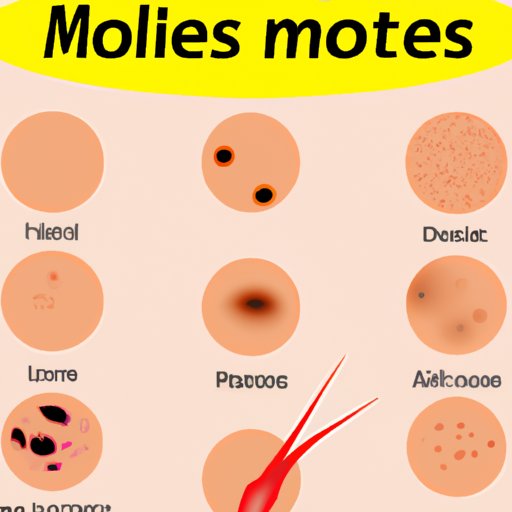Introduction
Skin moles are common growths on the skin that can range in size, shape, and color. They are usually harmless and do not require treatment, but some may need to be monitored or removed if they become cancerous. This article will discuss the causes and risk factors for skin moles, different types of skin moles, how many moles are considered normal, how skin moles can be diagnosed, treatments for skin moles, and home remedies for skin moles.

Causes and Risk Factors for Skin Moles
There are several potential causes and risk factors for skin moles. Genetics is one of the main causes of skin moles, meaning that if your parents had skin moles, you are more likely to have them as well. Sun exposure is another cause of skin moles, as UV rays can damage the skin and cause moles to form. Hormonal changes, such as those that happen during pregnancy or puberty, can also trigger the formation of skin moles.
Types of Skin Moles
There are three main types of skin moles: congenital nevi, acquired nevi, and dysplastic nevi. Congenital nevi are moles that are present at birth, while acquired nevi are moles that form after birth. Dysplastic nevi are moles that are larger than normal moles and can have irregular shapes, colors, and textures. These moles are more likely to become cancerous, so they should be monitored closely.
Is It Normal to Have a Lot of Skin Moles?
The average adult has between 10 and 40 moles, but it is not uncommon to have more. If you have more than 50 moles, it is important to monitor them closely and see a doctor if any of them change in size, shape, or color. Your doctor may recommend additional tests to check for skin cancer.

How Skin Moles Can Be Diagnosed
Skin moles can be diagnosed through a visual examination by a doctor. The doctor will look at the mole and assess its size, shape, color, and texture. In some cases, a dermatoscopy may be used to get a better view of the mole. During a dermatoscopy, a handheld device with a magnifying lens is used to examine the mole.
Treatments for Skin Moles
If a mole needs to be treated, there are several options available. Surgery is one option, and it involves removing the mole and sending it to a lab for testing. Cryotherapy is another option, which uses freezing temperatures to destroy the mole. Laser therapy can also be used to remove the mole, and it works by using intense heat to break down the mole tissue.
Home Remedies for Skin Moles
In addition to medical treatments, there are also several home remedies that can be used to reduce the appearance of skin moles. Apple cider vinegar is one popular remedy, as it can help lighten the color of the mole. Tea tree oil can also be applied to the mole to help reduce inflammation. Coconut oil can be used to moisturize the area around the mole and help reduce the appearance of the mole.
Conclusion
Skin moles are common growths on the skin that can range in size, shape, and color. While most moles are harmless, some may need to be monitored or removed if they become cancerous. Causes and risk factors for skin moles include genetics, sun exposure, and hormone changes. There are three main types of skin moles: congenital nevi, acquired nevi, and dysplastic nevi. The average adult has between 10 and 40 moles, though it is not uncommon to have more. Skin moles can be diagnosed through a visual examination or dermatoscopy, and treatments for skin moles include surgery, cryotherapy, and laser therapy. Home remedies for skin moles include apple cider vinegar, tea tree oil, and coconut oil.


